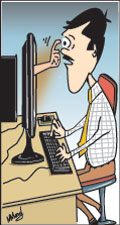It would be hard to find an office employee today who does not need to use a computer for at least some part of his or her work. As the computer has evolved from the desk to the lap, from the hand to the palm, user facility and comfort have become a key part of the research involved in improving these technologies.As with all products that sweep the market with huge success, the effects and long term consequences on the consumer and user come into focus soon after.
Ergonomics, which refers to how equipment is designed to fit the human body and its cognitive abilities, is now an important aspect of product design and user concern. The position of the screen in relation to one's eye level, the posture of the user, the position of shoulders, elbows and wrists are important aspects of ergonomics.
Equally important is the effect on the user's eye sight. Continuous use of computers, which has become the norm for many people, has led to discomfort, physical and visual ailments (Computer Vision Syndrome). The most common symptoms include headaches, focusing difficulties, burning eyes, tired eyes, general eyestrain, aching eyes, dry eyes, double vision, blurred vision, light sensitivity, and neck and shoulder pain.
Users should be aware of the protective eyewear available to them so that they can make the best choice regarding the equipment they select, as well as regarding their spectacle frames and lenses.
Anti-reflective lenses
Low reflection protective screens (glare screen filters) to be placed in front of computer screens became very popular once the eye fatigue due to constant computer use was assessed. A more personalised and convenient solution is anti-reflective lenses that provide very good protection against the reflection of light emanating from sources of light, such as television screens, computer screens and smartphones. Light from such sources reflect off lenses that do not have anti-reflective coating, thus reducing the quality of vision, sometimes creating distortions and generally making the eyes more tired quickly. An anti-reflective coating on the lenses will thus reduce the glare coming at you and from behind you that causes eyestrain.
Many lens manufacturers provide different types of anti-reflective coating, marketing them under various brands. Users can differentiate between the different types and the quality of the coating by checking if the coating is done on both front and back surfaces of the lens. Poor quality lens coating does not last long and can often be noticed by a “peeling off” or “patchy” effect on some parts of the lens surface.
Vision at all distances
The distance between the user and the computer screen can impact on the quality of vision. The eye focuses on close objects by a contraction of its ciliary muscles, which is called accommodation. For users below 40 years of age, when the muscles still function without problems, accommodating to near vision is not difficult. Therefore, they have no problems reading and do not need “reading glasses”.
For such users, focusing on a computer screen, which is generally placed further away from the normal reading distance (which is 16 inches or 40 cm) is not a problem. However, after the age of 40, the cilliary muscles stiffen and this makes it harder to focus on near objects. Therefore, users will need spectacles to assist them with computer use. The computer distance is neither the reading distance nor far vision. It is often referred to as intermediate vision. The ideal solution for this requirement is multifocal or progressive lenses that enable clear vision at all distances.
Multifocal lenses and special
computer lenses
The conventional bifocal correction is not recommended for working with a computer. Wearing bifocal glasses forces a computer user to tilt the head back and move closer to focus on the screen to see through the lower part of the bifocal lenses. Such a position can cause neck and shoulder pain, as well as back pain and headaches. In this situation, a lens that corrects at the intermediate distance (arms length, not near or far) is needed to adequately focus on the computer screen.
Multifocal lenses made for computer users (“computer glasses”) taking into consideration the computer distance can make a world of difference while using a computer. Not only do they correct blurred vision, but they also relieve symptoms caused by struggling to focus, such as headaches, eyestrain, tired eyes, and burning.
Lens design
Another option to prevent computer vision syndrome is to use aspheric lenses.An aspheric lens is a lens whose surfaces have a profile that is neither a portion of a sphere nor of a circular cylinder. This can not only cut down on spherical aberrations but also permit the use of a thinner lens. In conventional lens designs, a slight distortion is created when you look away from the centre of the lens — whether your gaze is directed to the left or right, above or below Aspheric lens designs reduce or eliminate these distortions for a wider field of view and better peripheral vision.
Some pointers
- Choose appropriate computer eyewear
- Minimise glare
- Blink more often and exercise your eyes
- Take frequent breaks
- Adjust your workstation: position your computer screen 20 to 24 inches from your eyes. The centre of your screen should be about 10 to 15 degrees below your eyes for comfortable positioning of your head and neck.
|


